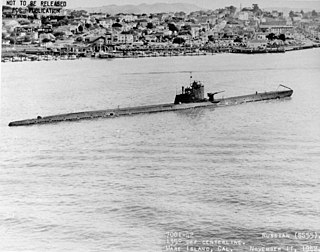Storozhevoy was the lead ship of her class of 18 destroyers built for the Soviet Navy during the late 1930s. Although she began construction as a Project 7 Gnevny-class destroyer, Storozhevoy was completed in 1940 to the modified Project 7U design.

The Gnevny class were a group of 29 destroyers built for the Soviet Navy in the late 1930s. They are sometimes known as the Gremyashchiy class and the official Soviet designation was Project 7. These ships fought in World War II.

The Leninets or L class were the second class of submarines to be built for the Soviet Navy. Twenty-five were built in four groups between 1931 and 1941. They were minelaying submarines and were based on the British L-class submarine, HMS L55, which was sunk during the British intervention in the Russian Civil War. Some experience from the previous Dekabrist-class submarines was also utilised. The boats were of the saddle tank type and mines were carried in two stern galleries as pioneered on the pre-war Russian submarine Krab (1912). These boats were considered successful by the Soviets. Groups 3 and 4 had more powerful engines and a higher top speed.
Kalinin (Калинин) was one of six Kirov-class cruisers built for the Soviet Navy in the Russian Far East from components shipped from European Russia during World War II. The ship was one of the last pair constructed, known as the Project 26bis2 subclass. Completed at the end of 1942 and assigned to the Pacific Fleet, she saw no action during the Soviet–Japanese War in 1945 and served into the Cold War. Sometimes serving as a flagship, her post-war career was uneventful until she was disarmed and converted into a floating barracks in 1960. She was scrapped in the early 1960s.

The Ronis-class submarines were built for the Latvian Navy in France in 1925. They were acquired by the Soviets in 1940 following the annexation of Latvia by the Soviet Union. They were scuttled in Liepāja in June 1941 as the Germans were about to capture the port. The hulls were raised in 1942 and scrapped.

S-2 was the second S-class submarine of the Soviet Navy. In early 1940, it entered Swedish territorial waters in the Sea of Åland where it hit a Swedish naval mine, and sank on January 2, 1940, with the loss of all 50 crew members.

S-7 was a Stalinets-class submarine of the Soviet Navy. Her keel was laid down by Krasnoye Sormovo in Gorkiy on 14 December 1936. She was launched on 5 April 1937 and commissioned on 30 June 1940 in the Baltic Fleet. During World War II, the submarine was under the command of Captain Sergei Prokofievich Lisin and took part in the Soviet submarine Baltic Sea campaign in 1942. S-7 scored victories, but was sunk in action.

Gnevny was the lead ship of her class of 29 destroyers built for the Soviet Navy during the late 1930s. Completed in 1938, she was assigned to the Baltic Fleet and played a minor role in the 1939–1940 Winter War when the Soviet Union invaded Finland. A few days after the start of the German invasion of the Soviet Union in June 1941, the ship struck a German mine and was badly damaged. After taking off the survivors, the Soviets failed to sink Gnevny with gunfire before they withdrew and the abandoned wreck drifted until she was sunk by German bombers three days later.

Rezvy was one of 29 Gnevny-class destroyers built for the Soviet Navy during the late 1930s. Completed in 1940, she was assigned to the Pacific Fleet.

Rastoropny was one of 29 Gnevny-class destroyers built for the Soviet Navy during the late 1930s. Completed in 1940, she was assigned to the Pacific Fleet.

Razyashchy was one of 29 Gnevny-class destroyers built for the Soviet Navy during the late 1930s. Completed in 1940, she was assigned to the Pacific Fleet and served until her sinking in 1961.

Rezky was one of 29 Gnevny-class destroyers built for the Soviet Navy during the late 1930s. Completed in 1942, she was assigned to the Pacific Fleet.

Rekordny was one of 29 Gnevny-class destroyers built for the Soviet Navy during the late 1930s. Completed in 1941, she was assigned to the Pacific Fleet.

Revnostny was one of 29 Gnevny-class destroyers built for the Soviet Navy during the late 1930s. Completed in 1941, she was assigned to the Pacific Fleet.

Razyaryonny was one of 29 Gnevny-class destroyers built for the Soviet Navy during the late 1930s. Originally named Peredovoy, she was renamed Razyaryonny before completion in late 1941, and was assigned to the Pacific Fleet.
Smely was one of 18 Storozhevoy-class destroyers built for the Soviet Navy during the late 1930s. Although she began construction as a Project 7 Gnevny-class destroyer, Smely was completed in 1941 to the modified Project 7U design.
Svirepy was one of 18 Storozhevoy-class destroyers built for the Soviet Navy during the late 1930s. Although she began construction as a Project 7 Gnevny-class destroyer, Svirepy was completed in 1941 to the modified Project 7U design.

S-55 was an S-class submarine of the Soviet Navy during World War II. At the start of the conflict it was part of the Pacific Fleet in Vladivostok, and it was sent to the Northern Fleet in late 1942, arriving at the Polyarny naval base in early 1943. During the war the submarine carried out four patrols and sank two transport ships before disappearing in December 1943.

S-1 was the lead ship of the S-class submarines of the Soviet Navy. It participated in the Winter War and the Soviet annexation of the Baltic states in 1940 before undergoing repairs and being scuttled by its crew in a shipyard at the start of Operation Barbarossa.

S-3 was the third boat of the S-class submarines of the Soviet Navy. The submarine took part in the Winter War and the Soviet annexation of the Baltic states before being sunk in the first days of Operation Barbarossa.








